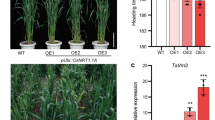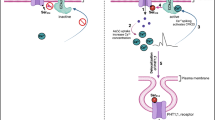Abstract
Metallothioneins (MTs) are a group of low molecular mass and cysteine-rich proteins that can chelate heavy-metal ions. In this paper, Northern blot analysis was used to investigate the influence of lead stress on the expression patterns of 10 rice class I MT genes (OsMT-Is) in rice seedlings. With the exception of OsMT-I-3b, the data demonstrate dynamic changes of 9 OsMT-I transcripts in response to Pb2+ treatment in rice seedling roots. Of these genes, transcription of OsMT-I-1a, OsMT-I-1b, OsMT-I-2c, OsMT-I-4a, OSMT-I-4b and OsMT-I-4c increased significantly, while transcription of OsMT-I-2a and OsMT-I-3a increased marginally. In contrast, the expression of OsMT-I-2b was inhibited. Pb2+ induced the expression of 6 OsMT-I genes in seedling shoots, but had no obvious effects on the expression of OsMT-I-1a, OsMT-I-1b, OsMT-I-4a and OsMT-I-4b. All the 10 OsMT-Is had enhanced lead tolerance when heterologously expressed in lead-sensitive yeast mutant cells. These results provide an expression profile of the rice MT gene family in response to Pb2+ stress in rice seedlings and demonstrate increased lead tolerance in sensitive yeast mutant cells expressing OsMT-Is. This study lays a foundation for further analysis of the role of the rice MT gene family in respond to Pb2+ stress.
Similar content being viewed by others
References
Laraque D, Trasande L. Lead poisoning: Successes and 21st century challenges. Pediatr Rev, 2005, 26(12): 435–443
Clemens S. Toxic metal accumulation, responses to exposure and mechanisms of tolerance in plants. Biochimie, 2006, 88(11): 1707–1719
Hall J L. Cellular mechanisms for heavy metal detoxification and tolerance. J Exp Bot, 2002, 53(366): 1–11
Coyle P, Philcox J C, Carey L C, et al. Metallothionein: The multipurpose protein. Cell Mol Life Sci, 2002, 59(4): 627–647
Li X, Hao S J, Liu Y, et al. Study on the form and stability of α and β domain of metallothionein binding to lead (II). J Hygiene Res, 2001, 30: 198–200
Lane B G, Kajioka R, Kennedy T D. The wheat germ Ec protein is a zinc containing metallothionein. Biochem Cell Biol, 1987, 65: 1001–1005
Murphy A, Zhou J, Goldsbrough P B, et al. Purification and immunological identification of metallothioneins 1 and 2 from Arabidopsis thaliana. Plant Physiol, 1997, 113(4): 1293–301
Giordani T, Natali L, Maserti B E, et al. Characterization and expression of DNA sequences encoding putative type-II metallothioneins in the seagrass Posidonia oceanica. Plant Physiol, 2000, 123(4): 1571–1582
Roosens N H, Bernard C, Leplae R, et al. Evidence for copper homeostasis function of metallothionein (MT3) in the hyperaccumulator Thlaspi caerulescens. FEBS Lett, 2004, 577(1–2): 9–16
Cobbett C, Goldsbrough P. Phytochelatins and metallothioneins: Roles in heavy metal detoxification and homeostasis. Annu Rev Plant Biol, 2002, 53: 159–182
Zhigang A, Cuijie L, Yuangang Z, et al. Expression of BjMT2, a metallothionein 2 from Brassica juncea, increases copper and cadmium tolerance in Escherichia coli and Arabidopsis thaliana, but inhibits root elongation in Arabidopsis thaliana seedlings. J Exp Bot, 2006, 57(14): 3575–3582
Zimeri A M, Dhankher O P, McCaig B, et al. The plant MT1 metallothioneins are stabilized by binding cadmiums and are required for cadmium tolerance and accumulation. Plant Mol Biol, 2005, 58(6): 839–855
Lee J, Shim D, Song WY, et al. Arabidopsis metallothioneins 2a and 3 enhance resistance to cadmium when expressed in Vicia faba guard cells. Plant Mol Biol, 2004, 54(6): 805–815
Schor-Fumbarov T, Goldsbrough P B, Adam Z, et al. Characterization and expression of a metallothionein gene in the aquatic fern Azolla filiculoides under heavy metal stress. Planta, 2005, 223(1): 69–76
Zhou J, Goldsbrough P B. Functional homologs of fungal metallothionein genes from Arabidopsis. Plant Cell, 1994, 6(6): 875–884
Akashi K, Nishimura N, Ishida Y, et al. Potent hydroxyl radical-scavenging activity of drought-induced type-2 metallothionein in wild watermelon. Biochem Biophys Res Commun, 2004, 323(1): 72–78
Dunaeva M, Adamska I. Identification of genes expressed in response to light stress in leaves of Arabidopsis thaliana using RNA differential display. Eur J Biochem, 2001, 268: 5521–5529
Mir G, Domenech J, Huguet G, et al. A plant type 2 metallothionein (MT) from cork tissue responds to oxidative stress. J Exp Bot, 2004, 55(408): 2483–2493
Yu L H, Umeda M, Liu J Y, et al. A novel MT gene of rice plants is strongly expressed in the node portion of the stem. Gene, 1998, 206(1): 29–35
Laraque D, Trasande L. Lead poisoning: Successes and 21st century challenges. Pediatr Rev, 2005, 26(12): 435–443
Zhou G K, Xu Y F, Liu J Y. Characterization of a rice class II metallothionein gene: tissue expression patterns and induction in response to abiotic factors. J Plant Physiol, 2005, 162(6): 686–696
Zhou G, Xu Y, Li J, et al. Molecular analyses of the metallothionein gene family in rice (Oryza sativa L.). J Biochem Mol Biol, 2006, 39(5): 595–606
Sherman F. Getting started with yeast. Methods Enzymol, 1991, 28: 3–20
Bovet L, Eggmann T, Meylan-Bettex M, et al. Transcript levels of AtMRPs after cadmium treatment: Induction of AtMRP3. Plant Cell and Environ, 2003, 26: 371–381
De Freitas J, Wintz H, Kim JH, et al. Yeast, a model organism for iron and copper metabolism studies. Biometals, 2003, 16(1): 185–197
Song W Y, Sohn E J, Martinoia E, et al. Engineering tolerance and accumulation of lead and cadmium in transgenic plants. Nature Biotechnol, 2003, 21(8): 914–919
Author information
Authors and Affiliations
Corresponding author
Additional information
Supported by the State Key Basic Research and Development Plan of China (Grant No. 2006CB101706) and the National Natural Science Foundation of China (Grant Nos. 30270753 & 30370804)
About this article
Cite this article
Xu, Y., Zhou, G., Zhou, L. et al. Expression patterns of the rice class I metallothionein gene family in response to lead stress in rice seedlings and functional complementation of its members in lead-sensitive yeast cells. CHINESE SCI BULL 52, 2203–2209 (2007). https://doi.org/10.1007/s11434-007-0335-5
Received:
Accepted:
Issue Date:
DOI: https://doi.org/10.1007/s11434-007-0335-5




